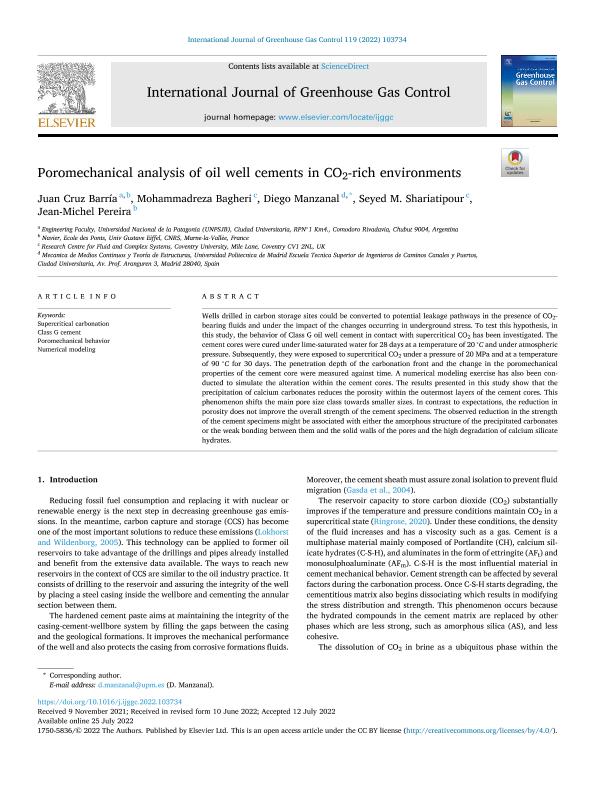Artículo
Poromechanical analysis of oil well cements in CO2-rich environments
Barría, Juan Cruz ; Bagheri, Mohammadreza; Manzanal, Diego
; Bagheri, Mohammadreza; Manzanal, Diego ; Shariatipour, Seyed M.; Pereira, Jean Michel
; Shariatipour, Seyed M.; Pereira, Jean Michel
 ; Bagheri, Mohammadreza; Manzanal, Diego
; Bagheri, Mohammadreza; Manzanal, Diego ; Shariatipour, Seyed M.; Pereira, Jean Michel
; Shariatipour, Seyed M.; Pereira, Jean Michel
Fecha de publicación:
09/2022
Editorial:
Elsevier
Revista:
International Journal of Greenhouse Gas Control
ISSN:
1750-5836
Idioma:
Inglés
Tipo de recurso:
Artículo publicado
Clasificación temática:
Resumen
Wells drilled in carbon storage sites could be converted to potential leakage pathways in the presence of CO2-bearing fluids and under the impact of the changes occurring in underground stress. To test this hypothesis, in this study, the behavior of Class G oil well cement in contact with supercritical CO2 has been investigated. The cement cores were cured under lime-saturated water for 28 days at a temperature of 20 ∘C and under atmospheric pressure. Subsequently, they were exposed to supercritical CO2 under a pressure of 20 MPa and at a temperature of 90 ∘C for 30 days. The penetration depth of the carbonation front and the change in the poromechanical properties of the cement core were measured against time. A numerical modeling exercise has also been conducted to simulate the alteration within the cement cores. The results presented in this study show that the precipitation of calcium carbonates reduces the porosity within the outermost layers of the cement cores. This phenomenon shifts the main pore size class towards smaller sizes. In contrast to expectations, the reduction in porosity does not improve the overall strength of the cement specimens. The observed reduction in the strength of the cement specimens might be associated with either the amorphous structure of the precipitated carbonates or the weak bonding between them and the solid walls of the pores and the high degradation of calcium silicate hydrates.
Archivos asociados
Licencia
Identificadores
Colecciones
Articulos(SEDE CENTRAL)
Articulos de SEDE CENTRAL
Articulos de SEDE CENTRAL
Citación
Barría, Juan Cruz; Bagheri, Mohammadreza; Manzanal, Diego; Shariatipour, Seyed M.; Pereira, Jean Michel; Poromechanical analysis of oil well cements in CO2-rich environments; Elsevier; International Journal of Greenhouse Gas Control; 119; 9-2022; 1-14
Compartir
Altmétricas



